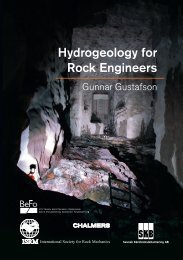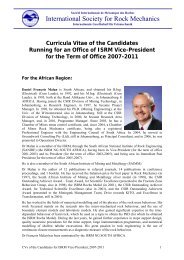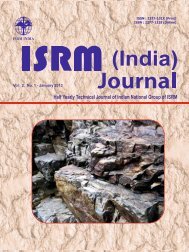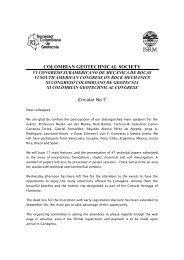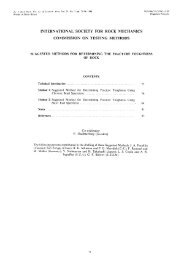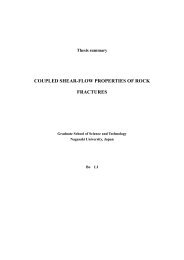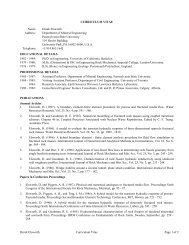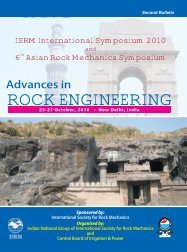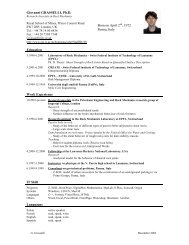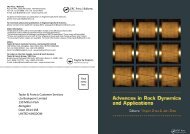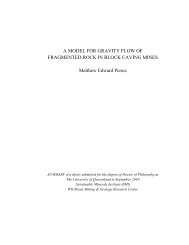ISSN : 2277-1328 (Online) - ISRM
ISSN : 2277-1328 (Online) - ISRM
ISSN : 2277-1328 (Online) - ISRM
Create successful ePaper yourself
Turn your PDF publications into a flip-book with our unique Google optimized e-Paper software.
Supporting Collapsed and Highly Deformed Areas of Block Cave Extraction Levels<br />
5<br />
residual strength, or something closer to it is attained.<br />
Relatively low cave loads will cause large amounts<br />
further damage.<br />
3. AN EXAMPLE PROCEDURE FOR SIMULATING<br />
SUPPORT CAPACITY AND DEMAND FOR BLOCK<br />
CAVING MINES (AFTER BECK ET AL 2010)<br />
Beck et al (2010) outline fundamental sufficiency<br />
requirements for properly simulating deformation on<br />
extraction levels and undercuts of block caves. In<br />
summary:<br />
• Generally, displacement realistic models will usually<br />
be 3D.<br />
• Capturing the geometry of a problem is essential to<br />
simulate the stress path and this means not only<br />
representing the shape of excavations and structure,<br />
but also simulating the timing and the excavation<br />
process.<br />
• Assuming a sufficient type and density of elements is<br />
used and the analytical framework can solve for the<br />
physical response that needs to be captured, the<br />
practical challenge for ground support problems is to<br />
simulate the continuous and discontinuous parts of<br />
the deformation field around a drive. This implies that<br />
the model will capture the stress strain behaviour well<br />
enough to model the extent and magnitude of damage<br />
around the excavation (for example with a strainsoftening,<br />
dilatant, large strain model), but also<br />
incorporate sufficiently small scale structure so that<br />
the discontinuous deformation and kinematics of the<br />
problem are captured.<br />
• The behaviour at many length scales, and the<br />
interconnectedness between different length scales<br />
(tunnel, pillar precinct, block and mine) must be<br />
captured. Deformation and damage at each length<br />
scale must built upon to simulate successively larger<br />
length scales and this should be achieved by<br />
incorporating geometry and sequencing details at a<br />
resolution and complexity suiting the smallest length<br />
scale of interest in the problem, but inside a model<br />
with similar complexity at longer length scales or using<br />
appropriate sub modeling techniques.<br />
At this time, it is not efficient to build a single mine-scale<br />
model with all scales of necessary structure from<br />
development (drive) scale to global (mine scale). Instead,<br />
a multi-scale sub-modelling approach can be adopted,<br />
using larger scale (global)models to provide boundary node<br />
displacements for smaller scale (sub) models, each with<br />
successively smaller scale details (see for example Beck<br />
2008 and Beck et al 2009).<br />
A simple example of donor and sub models is shown in<br />
Figure 2 after Beck et al (2010). The purpose of this model<br />
was to evaluate the capacities of the steel arches and<br />
steel sets for block caving drawpoint support. A global<br />
model of the entire mine was used to drive the boundaries<br />
of a 1/10 footprint sub model spanning from below the<br />
extraction level to above the undercut. Because many<br />
support designs needed to be tested, the drives within<br />
the 1/10 footprint sub model were only filled with supporting<br />
‘filler’ elements approximating the pre-failure stiffness of<br />
the systems that were being studied. The displacements<br />
at the drive surface could then be applied to the explicit<br />
models of the support elements or directly compared to<br />
published load-displacement data (Villaescusa, et al,<br />
1992). In more detailed studies, the support can be<br />
included directly in the 1/10 footprint model, in order to<br />
achieve the required resolution of discontinuities.<br />
In this particular example, the 1/10 footprint models<br />
incorporate Discrete Fracture Networks (DFN) to represent<br />
drive scale structure. The included discontinuities are<br />
shown in the sub model plots. The DFN are based on a<br />
statistical representation of the discontinuity spatial<br />
distribution, as outlined in Beck et al (2010).<br />
The results for excavation closure from this model at an<br />
isolated location in which large deformation leads to high<br />
Fig. 2 : Example sections through a 1/10 footprint DFN and<br />
global donor model used to produce drive surface<br />
displacements to test steel arch and steel set support. Only<br />
part of the model is shown.<br />
Volume 1 No. 2 July 2012




